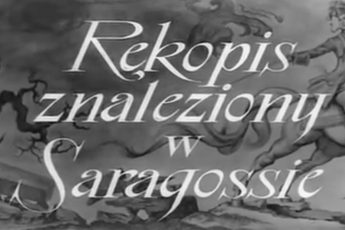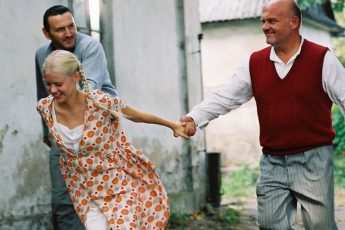From Enlightenment to Surrealism: Did Wojciech Has Betray the Spirit of Jan Potocki?
Wojchiech Jerzy Has’ The Saragossa Manuscript (Rękopis znaleziony w Saragossie, 1964)
Vol. 46 (October 2014) by Pau Bosch Santos
The Manuscript Found in Saragossa, the French-written book by count Jan Potocki and the eponymous adaptation by Wojciech J. Has, share somewhat parallel fates. Notably, there are three cuts of the film and, so far, three known versions of the novel. None of the novel’s auto-graphic versions, however, could have served as the basis for Has’ film, since they were only unearthed in 2002, when two Potocki scholars, François Rosset and Dominique Triaire, subjected all of the known surviving materials to close scrutiny. At the time Has shot his film, 1964, the only “full version” of the novel that existed was the 1847 Polish translation by Edmund Chojecki. Except that, of course, Chojecki’s translation was not really the translation of one single work, but a potpourri or chimera consisting of a rather arbitrary assemblage of those of Potocki’s manuscripts Chojecki could get his hands on. The result was a cut and paste carnage of fragments that hardly fit together, or a masterpiece of intertextuality. (By the way: René Radrizzani had to struggle with Chojecki’s version in order to arrive at the first complete French version, which had to wait until 1989 — at some points he, Radrizzani, was so baffled that he gave up and translated straight from Polish — while Radrizzani’s version in turn served as the original for all subsequent translations, e.g. the Penguin one by Ian MacLean.)1
In Chojecki’s as well as in Potocki’s versions, the novel is a voyage of initiation of its main character, or rather a Bildungsroman, the coming-of-age story of the man of the Enlightenment. It begins in a world in which everything seems to be the work of mythical forces such as demons, evil spirits and enchantments. But, as stories unfold and ever more points of view join the scene, what had looked like the product of supernatural powers progressively finds a totally natural explanation in terms of human agents (and a good dose of chance, too). A case in point is Toledo’s highly unlikely series of coincidences (which Has takes up in his feature): a presumed voice from the afterlife is finally revealed as no more than the voice of a guy who mistakenly knocked at your window the very same night your best friend was dueling and had promised to tell you about the after-world should he die (which he did).
Thus, as in any Enlightenment novel worth its salt, old dogmas are scorned and derided, untested certainties and beliefs are brought to trial, and authority figures like fathers and priests are made into fools. Together with a huge sample of human types (from noblemen to merchants, bandits, gypsies, moors, cabalists, inquisitors, men of science, rascals, jealous husbands or libidinous women, to name but a few) and their respective worldviews, the book deploys a near-full spectrum not only of literary genres, but also of kinds of discourse, all of which parade on an equal footing.2 But where do all the stories, where do all the historical, religious, philosophical and scientific disquisitions usher? At the end of Potocki’s book, all roads lead to the underworld kingdom of Sheikh Gomelez. Except when the main characters, summoned by the Great Sheikh, go down to the bottom of the mine, what they find out is that the gold vein, which for a thousand years had been exploited and seemed inexhaustible, is finally worn down. The message of the Manuscript, then, as Rosset and Triaire put it, would be that “all roads are good, as they all allow us to reach the goal; the problem is that, in the meantime, the goal has been emptied of its substance.”3
Potocki thus wrote a novel about an enlightened world emptied of its magic. But the book can also be read as a huge novel on paranoia. Indeed, only someone as naïve and simple-minded as Alphonse van Worden, protagonist of book and film, can be the unwitting pawn of as enormous an intrigue as he is and not suffer persecution mania for the rest of his life.
This is precisely where Wojciech Has takes up the story. It seems that Has, fascinated and perplexed by the utterly surreal character of van Worden’s adventures, saw the opportunity to make a movie that casts doubt precisely on the explanations given to poor Alphonse at the end of the novel. What Has deemed fantastic and blatantly surreal, then, were not merely the first Gothic-novel episodes of the book, but the whole setup built around Alphonse. As if he thought: “My dear friend, you must have dreamt something like that. Such things don’t happen in the real world. No one would go through so much trouble for a poor fool like you.”
The core matter in Has’ movie is therefore the dim line that separates dream from wakefulness, delusion from reality, map from territory. Has gives us countless clues in this regard. The first image we have of Alphonse is him lying belly down, neither sleeping nor fully awake, but looking rather astonished, as if he’d just fallen. And when he leaves the scene he leaves behind a map of Sierra Morena that seems to melt with the landscape. Later on Alphonse himself states it crystal clear after the first of the gypsy chief’s stories: “All that has made me confused. I’ve lost the feeling of where reality ends, and fantasy takes over.”
What lurks around the corner for someone unable to tell whether he has dreamt or imagined such wonders as Alphonse’s, Has tells us with the final scene, is madness. After a night during which the secret of the Gomelez is disclosed to him and he is about to touch his own double, Alphonse wakes up (once and for all, one would think) under the gallows again, only this time next to his servants, pretty distressed but apparently unsurprised to find the book that the Great Sheikh had entrusted him lying open on the lap of one of them. They then ride to the little inn where he will write down his adventures in an almost delirious state. But when he finally sees (or thinks he sees) his cousins Emina and Zibelda one more time, he breaks into hysterical laughter and throws the book away, scampering away at full gallop. And yet he is once again headed towards the gallows. One cannot tell whether he is desperately trying to escape madness, or has definitely surrendered to it. Neither is the spectator (nor Alphonse) able to tell whether it all has been a dream – perhaps the product of a sick mind – or whether Alphonse has actually been the object of such a huge and collectively orchestrated deception.
A book about the disenchantment of the world has become a film about the enchantment of man. It would seem as if Has had betrayed the spirit of Potocki’s novel and done it through a fairly faithful adaptation (inasmuch as a three-hour film can be expected to cluster a some eight-hundred-page book). What had been a chant to Enlightenment turns, in Has’ hands, into a hymn against Socialist realism and the Soviet regime in general — which (ironically) considers itself part of the offspring, if not the only legitimate heir, of Enlightenment and its ambition to reshape human nature. Alphonse’s fate would be a demonstration of the ultimate achievement of the “engineers of the human soul,” as Stalin infamously called Soviet writers.
Which brings us full circle to the aforementioned three cuts of the film. Has himself made the first two: the full-length movie (178 min.), which he sent to Cannes, only to vanish, and was then re-discovered and restored in 2001 thanks to Coppola and Scorsese, with a short copy (124 min.) being internationally distributed. But then, unbeknownst to him, a medium-length version (150 min.) started to circulate in the middle 80’s as the alleged full version. As Anne Guérin-Castell explains in full detail on her website,4 that was the work of censorship, to which the subtle ironies and political as well as religious allusions of the film didn’t go undetected.5
But despite all the dissimilarities between novel and film, and despite the fact that the film’s unabashed surrealism and the corrosive allusions within it make of it a sharp manifesto against Soviet aesthetics and politics, what we see in both book and movie is first and foremost a bunch of people with radically different beliefs and worldviews and life projects and ambitions and interests, in sum a bunch of people who have apparently nothing to do with each other, being capable of listening to and learning from each other. If what Potocki understood Enlightenment to mean was something like “Hey guys, we’re all in the same boat. After thousands of years of political and religion and individual wars that have shaken our consciences and certitudes and faiths we’re all sitting here together out in the open and that’s the only thing that really matters, i.e. the fact that we’ve all put aside our differences just to sit with and listen to and simply be here with each other,” and if that’s what Has saw in the novel, then maybe Has didn’t betray the spirit of Potocki, maybe he wasn’t criticizing Enlightenment per se, but just a misconception of Enlightenment, or some aftermaths of it.




Leave a Comment